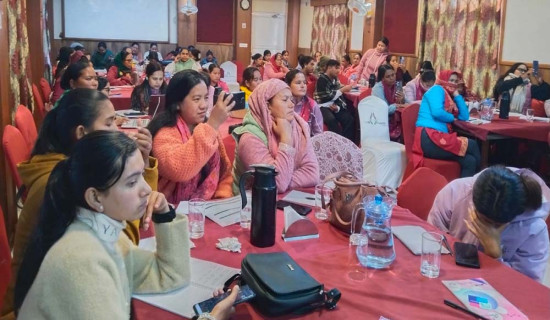- Thursday, 25 December 2025
Mystical Mustang
Saudamini Chalise
Mustang, the last frontier of the trans-Himalayan fiefdom, is a land cloaked in a mystical veil of enigmatic parables. The facades in the upper and lower Mustang have kaleidoscopic natural rejigging. The amber-hued mountains guard the region with their majestic presence, exuding a veneered pastiche of mother nature.
From its surreal semi-arid desert to motley formations of rock, snow-kissed mountains, and the stark contrast of green crop fields amidst the off-beaten landscape akin to a desert, it's a homeland of juxtaposing panorama. Opined as the "Plain of the Aspirations" in the Tibetian language, it simply oscillates with a sense of alchemy.
Man-made Caves
The villages are set off quite at the distance from each other. They seem to be a phantasm. This forbidden land rests between the elevation of 1,372 metres to 8,167meters and is neighbouring the Tibetian plateau, Annapurna mountain, and Dhaulagiri mountain. It is home to possibly more than 10,000 man-made caves which adds zing to the curiosity of the passersby, leaving them enthralled with awe.
The caves were home to 2,000 to 3,000 old mummified human bodies. One can not but wonder in disbelief and fascination while observing the caves formed almost like honey-combed formations and strive to fathom the idea behind it. The heart of the nomadic backpackers often paraglides in enchantment, waltzing while being in tune with the rhythms of winds that flow majestically throughout the Mustang and the barren desert giving off the feeling of treading beyond the last frontiers.
Dzong-Sampa or Jomsom is the headquarters of Mustang. The Annapurna Conservation Project (ACAP) envelopes the district of Mustang spanning over 3,573km square. With its barren deserts, bizarre-looking caves, and corroded canyons, Mustang has a uniquely picturesque landscape. The acute contrast in the scenery embodying elevated snow-peaked mountains to barren-looking hills and desert to greenery foliage in the fields leaves anyone with lingering panache for more.
A permit is required for trekking-related activities from the Annapurna Conservation Project and Trekkers information management system and a special permit is needed to venture into the Upper Mustang region. Mustang is acclaimed for its trans-Himalayan bio-diversities. Paraphernalia of wild animals such as Tibetian Gazelle, Tibetian wild ass, snow leopard, and musk deer are of this region.
Similarly, Mustang has 29 species of mammals,105 species of bird, five snake species, eight lizard species, 1 spider species, 25incests species, five species of zooplankton, and two molluscs species, 5 species of butterflies to its cap. The plants from the Mustang region have high ethnomedicinal and economical values. Above the elevation of 5,000 metres, there is no sign of vegetation due to extreme frigid weather.
The rural face of Mustang is reflected in Lo Manthang, the abode of royal legacies of the bygone eras, its reminiscents can still be perceived in this locale. The four temples, Jhampa Gompa(God House), Thubechen Gompa, Chodey Gompa, and Choprang Gompa of the Lo are the crowd gatherers, which were built in the 15th century. The fusion of Tibetian Buddhism and Sanatan Dharma can be felt in practice.
The presence of pulchritudinous mountains enveloping its periphery invokes a sense of pride and oneness with the cosmic drama enacted down on the earth. The gusts of fresh air caressing the cheeks excite and titillate the heart for more of this exotic paradise on earth. Mustang's rich and diverse history is shrouded in mystery and filled with legends and lore. The trekking itinerary is usually tailored and suited according to it to the palates of the backpackers. The depths of the Kali-Gandaki gorge can be fathomed from Jomsom, perhaps one of the deepest ravines in the world.
The feeling of a mighty guardian looking over from their clouded veiled abode in silence strikes the passersby. The trekkers, nature lovers, or simply backpackers, all leave behind a piece of their hearts in Mustang. The denizens of Mustang are the traders of the Thakali tribe, of the Tibetian roots, gradually the rabbles living around the periphery of the "Thak Khola" were called the Thakalis.
Diverse Annapurna
However, the people mostly from the southern part of Mustang regard themselves as the bonafide "Thakalis". Among the Thakali tribe, the Tamang Thakalis have a unique symbolic reference to their tribes such as Gauchans (Elephant/ Red), Tulachans (Dragon / Red or Blue), Juharchans (Jewel), and Panaachans (Emerald). Ghandruk, Sikles, Lwang, and Bhujung from the southern face of the Annapurna range and Lo Manthang, Jomsom, and Manang from the trans-Himalayan region are the 7 unit conservations offices designated by the Annapurna Conservation Area Project.
Although potpourris of impediments do delay the pace of programmes related to conservation, the unforeseen speed breakers are overpowered by meticulous zeal and incessant elbow grease, and conservations of biologically diverse Annapurna are ceaselessly being executed with the ample amount of participation from the local populations of Mustang.
(The author holds Master's degree in travel and tourism)
How did you feel after reading this news?

















